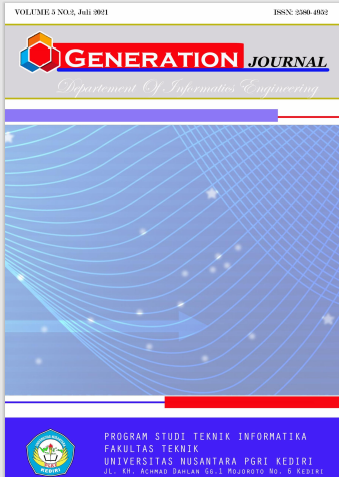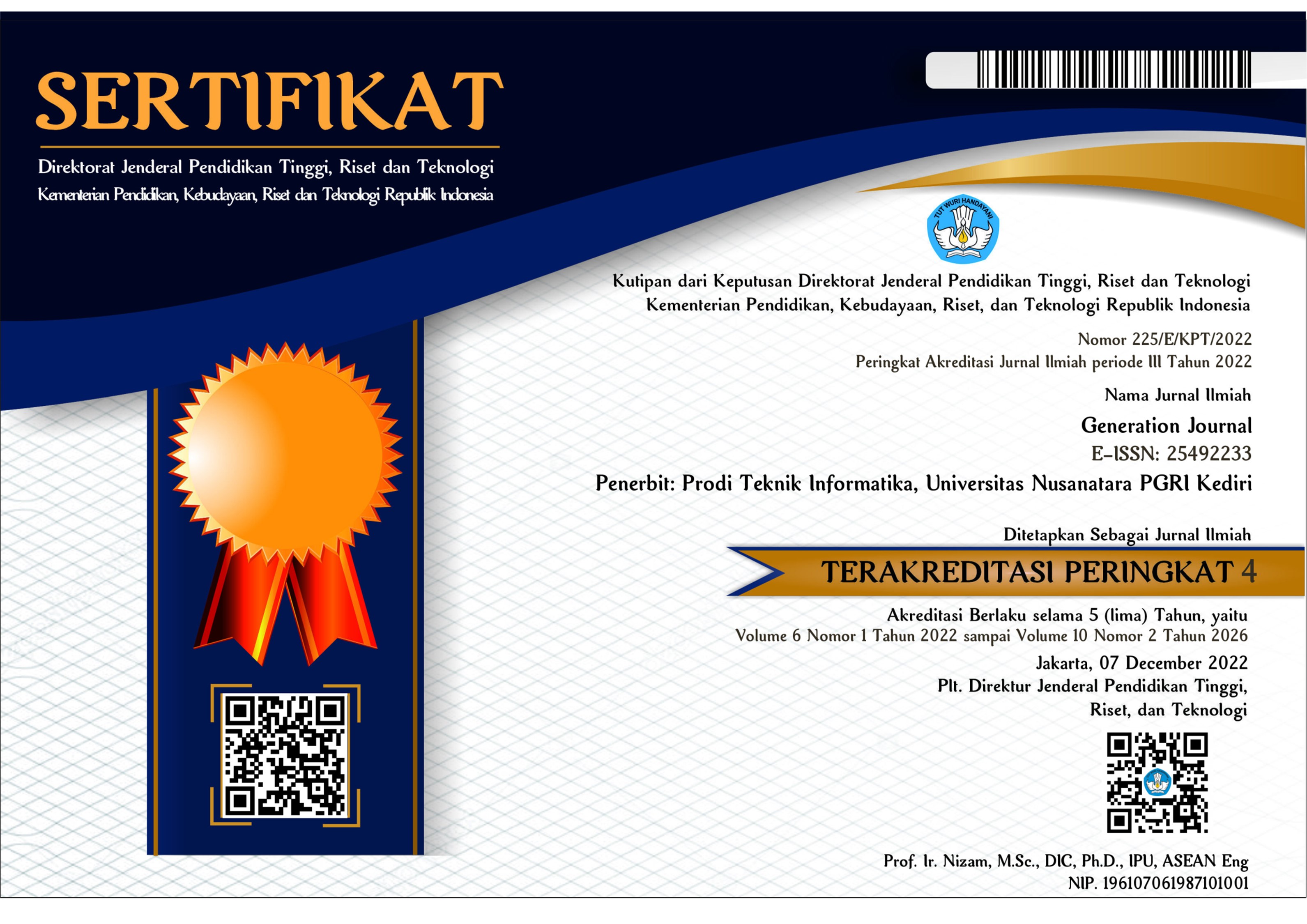Klasifikasi Pengguna Shopee Berdasarkan Promosi Menggunakan Naïve Bayes
DOI:
https://doi.org/10.29407/gj.v5i2.15998Keywords:
Classification, E-Commerce, Naïve Bayes, PromotionAbstract
Online shopping is a transaction of buying and selling goods or services through intermediary media, namely social networks. There has been a change in consumption patterns and the way people spend their money, which was originally conventional to switch to E-Commerce services due to several factors, namely the increasing public interest in online shopping due to the COVID-19 virus outbreak, and throughout 2019 E-Commerce users who made transactions reached 168.3 million people. . Based on iprice report data in 2020, Shopee is the most visited E-Commerce with a total of 129,320,800 visitors. Shopee is only a third party that provides a place to sell and payment facilities, therefore Shopee is not responsible for marketing the products sold. To attract consumers, sellers need attractive promotions. Therefore, research is needed to classify E-Commerce users. The purpose of this research is to classify E-Commerce users based on the promotion used using the Naïve Bayes algorithm with the Knowledge Discovery in Database (KDD) methodology. Nine test scenarios were carried out with cross validation which showed that the best performance was a test scenario using 3 folds which resulted in performance with an accuracy value of 88.73%, and with a kappa value of 0.451 which was included in the moderate category. Based on these results, the model generated by the Naïve Bayes algorithm is quite consistent.
References
D. A. Harahap, "Perilaku belanja online di Indonesia: studi kasus," JRMSI - Jurnal Riset Manajemen Sains Indonesia, vol. 9, no. 1, pp. 193-213, 2018.
N. R. Yunus dan A. Rezki, “Kebijakan Pemberlakuan Lock Down Sebagai Antisipasi Penyebaran Corona Virus Covid-19,” SALAM: Jurnal Sosial Dan Budaya Syar-I, vol. 7, no. 227-238, p. 3, 2020.
G. Nurdian, “Graha Nurdian,” 14 Februari 2021. [Online]. Available: http://grahanurdian.com. [Diakses 3 Maret 2021].
"Peta E-Commerce Indonesia," 2020. [Online]. Available: https://iprice.co.id/insights/mapofecommerce/.
Ardiyansyah and P. A. Rahayuningsih, "Penerapan teknik sampling untuk mengatasi imbalance class pada klasifikasi online shoppers intentionenri," Jurnal Teknik Informatika Kaputama (JTIK), vol. 4, no. 1, pp. 7-14, 2020.
A. M. Siregar dan A. Puspabhuana, Data Mining: Pengolahan Data Menjadi Informasi dengan RapidMiner, CV Kekata Group, 2017.
I. Ranggadara, G. Wang dan E. R. Kaburuan, “Applying Customer Loyalty Classification with RFM and Naïve Bayes for Better Decision Making,” 2019 International Seminar on Application for Technology of Information and Communication (iSemantic), pp. 564-568, 2019.
I. Romli, E. Pusnawati dan A. Siswandi, “PENENTUAN TINGKAT PENJUALAN MOBIL DI INDONESIA DENGAN MENGGUNAKAN ALGORITMA NAIVE BAYES,” e-Prosiding SNasTekS, vol. 1, no. 1, pp. 367-380, 2019.
H. F. Putro, R. T. Vulandari dan W. L. Y. Saptomo, “Penerapan Metode Naïve Bayes Untuk Klasifikasi Pelanggan,” Jurnal Teknologi Informasi dan Komunikasi (TIKomSiN), vol. 8, no. 2, 2020.
R. N. Devita, H. W. Herwanto and A. P. Wibawa, "Perbandingan kinerja metode naïve bayesian dan k-nearest neighbor untuk klasifikasi artikel berbahasa Indonesia," Jurnal Teknologi Informasi dan Ilmu Komputer (JTIIK), vol. 5, no. 4, pp. 427-434, 2018.
S. Rohmatunisha, U. Wahyudi and D. S. Yudasmara, "Survei minat siswa dalam mengikuti kegiatan ekstrakurikuler bolabasket pada peserta sekolah menengah pertama," Sport Science and Health, vol. 2, no. 2, pp. 119-129, 2020.
M. D. Purbolaksono, M. I. Tantowi, A. I. Hidayat dan A. , “Perbandingan Support Vector Machine dan Modified Balanced Random,” JURNAL RESTI (Rekayasa Sistem dan Teknologi Informasi), vol. 5, no. 2, pp. 393-399, 2021.
M. A. Muslim, E. Sugiharti, B. Prasetiyo dan S. Alimah, “Penerapan Dizcretization dan Teknik Bagging Untuk Meningkatkan Akurasi Klasifikasi Berbasis Ensemble pada Algoritma C4. 5 dalam Mendiagnosa Diabetes,” Lontar Komputer: Jurnal Ilmiah Teknologi Informasi, vol. 8, no. 2, pp. 135-143, 2017.
D. Nofriansyah, Konsep Data Mining Vs Sistem Pendukung Keputusan, Yogyakarta: Deepublish, 2014.
A. Mukminin dan D. Riana, “Komparasi Algoritma C4.5, Naïve Bayes Dan Neural Network Untuk Klasifikasi Tanah,” JURNAL INFORMATIKA, vol. 4, no. 1, pp. 21-31, 2017.
R. Y. Hayuningtyas, “Penerapan Algoritma Naïve Bayes untuk Rekomendasi,” JURNAL INFORMATIKA, vol. 6, no. 1, pp. 18-22, 2019.
D. Sartika dan D. I. Sensuse, “Perbandingan Algoritma Klasifikasi Naive Bayes, Nearest Neighbour, dan Decision Tree pada Studi Kasus Pengambilan Keputusan Pemilihan Pola Pakaian,” JATISI (Jurnal Teknik Informatika dan Sistem Informasi), vol. 3, no. 2, pp. 151-161, 2017.
S. Hulu, "Analisis kinerja metode cross validation dan k-nearest neighbor dalam klasifikasi data," Sumatera Utara, 2020.
U. Enri, “Penerapan Algoritma C4.5 Dalam Pemilihan Program Studi Fakultas Ilmu Komputer (Studi Kasus Sekolah Menengah Atas Negeri 1 Tambun Utara),” URNAL REKAYASA INFORMASI, vol. 7, no. 1, 2018.
A. M. WS, I. P. Ananda, M. A. Rizki, Z. D. Hapsari dan R. Nooraeni, “Penerapan Metode Resampling dalam Mengatasi Imbalanced Data Pada Determinan Kasus,” Jurnal MSA (Matematika dan Statistika serta Aplikasinya), vol. 8, no. 1, pp. 19-27, 2020.
Downloads
Published
Issue
Section
License
Authors who publish with this journal agree to the following terms:
- Copyright on any article is retained by the author(s).
- The author grants the journal, the right of first publication with the work simultaneously licensed under a Creative Commons Attribution License that allows others to share the work with an acknowledgment of the work’s authorship and initial publication in this journal.
- Authors are able to enter into separate, additional contractual arrangements for the non-exclusive distribution of the journal’s published version of the work (e.g., post it to an institutional repository or publish it in a book), with an acknowledgment of its initial publication in this journal.
- Authors are permitted and encouraged to post their work online (e.g., in institutional repositories or on their website) prior to and during the submission process, as it can lead to productive exchanges, as well as earlier and greater citation of published work.
- The article and any associated published material is distributed under the Creative Commons Attribution-ShareAlike 4.0 International License














